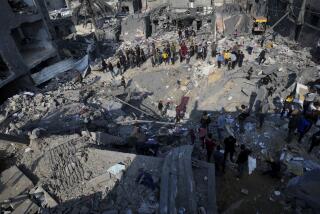Head of Joint Chiefs Defends Use of Cluster Bombs in Iraq
WASHINGTON — The chairman of the Joint Chiefs of Staff defended the U.S. military’s use of cluster bombs in Iraq, saying Friday that only 26 of the devices, which shower “bomblets” over a target, fell in civilian areas and that there was only one case of death or injury to a noncombatant.
Air Force Gen. Richard B. Myers, the nation’s top military officer, did not provide details on that single case.
His remarks came amid persistent reports from Baghdad that children and other civilians are being killed or maimed by bomblets that did not explode when they hit their initial targets but did when people stumbled across them later.
“Coalition forces used cluster munitions in very specific cases against valid military targets and only when they deemed it was a military necessity,” Myers said.
He said about 1,500 cluster bombs were used in the war and the 26 dropped in populated areas were aimed at military targets the Iraqi regime placed near civilians.
Myers acknowledged that “in some cases, we hit those targets knowing that there would be a chance of potential collateral damage,” using a military term for civilian casualties. But he stressed that “the regime chose to put many of these military assets in populated areas and then from those areas fired on our forces.”
Myers’ assertions were challenged by human rights organizations, which said they had learned Friday of new injuries to civilians in Baghdad and other Iraqi cities.
Weapons experts also said Myers’ remarks are somewhat misleading because his account of the U.S. military’s use of cluster bombs does not cover similar weapons dispersed by rockets and ground artillery.
Because they are not dropped from airplanes, those weapons are not considered “cluster bombs” in Pentagon parlance, the experts said. Even so, they added, the weapons have a similar effect and, in many cases, higher “dud rates.”
“I’m hearing about a lot of surface-delivered cluster munitions in the suburbs,” said Mark Hiznay, senior researcher in the arms division of Human Rights Watch in Washington. “They’re hanging in the trees. They’re sitting on the ground.”
Human Rights Watch and other organizations, as well as doctors in Baghdad, have reported hundreds of casualties from cluster bombs or similar devices.
Unlike traditional munitions, cluster bombs splinter into dozens if not hundreds of smaller explosive pieces -- “bomblets,” or submunitions -- before striking their targets. Though cluster bombs are opposed by many groups, their use is not illegal under international law.
The Pentagon came under heavy criticism for civilian casualties stemming from the use of cluster bombs in the 1999 war in Yugoslavia. Experts said the military curtailed its use of the munitions in the war in Afghanistan.
In Iraq, a Pentagon official said, cluster bombs represented about 5% of the 30,000 munitions dropped from airplanes or delivered from ships. When cluster bombs were used in populated areas, the official said, the military used a precision-guided version equipped with a directional device to help minimize the chance that the bomb might drift from its intended target.
But the official said that the Pentagon does not keep track of surface-fired submunitions.
Myers said cluster bombs were used to hit targets including mobile communications units, aircraft and armored vehicles, as well as groups of soldiers.
Militarily, experts said, they are unquestionably effective.
“If you want to ask what happened to the Republican Guard, why their counterattack was ineffective,” said John Pike, an analyst at Globalsecurity.org, “it was basically submunitions and the well-founded fear of submunitions.”
The most sophisticated cluster bombs are designed to divide into 40 pieces, each of which has heat-seeking sensors that guide them toward tanks and other vehicles. On contact, they emit an armor-piercing jet of molten copper.
Surface-fired submunitions are far less sophisticated. Hiznay said one surface-launched rocket system used by the U.S. Army and Marine Corps is the M-26, a warhead that carries 644 submunitions. He said studies have shown that 16% of those submunitions will fail to function, meaning they disperse duds that could explode later.
Pike said many of the reported civilian casualties in Baghdad appear to be concentrated on the west side of the capital, where surface-fired submunitions were directed at convoys of Iraqi military vehicles on a six-lane highway with civilian houses on both sides.
Residents of Baghdad have described finding dozens of soda can-size bomblets, as well as small colored balls that children might confuse with a toy.
One case in Baghdad centered on a young girl who delivered an unexploded device to a group of Marines. The device exploded, injuring the girl and four U.S. servicemen. Myers said Friday that device was not from a cluster bomb.
More to Read
Sign up for Essential California
The most important California stories and recommendations in your inbox every morning.
You may occasionally receive promotional content from the Los Angeles Times.










